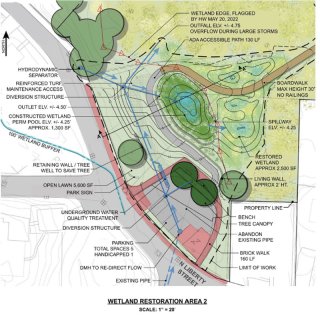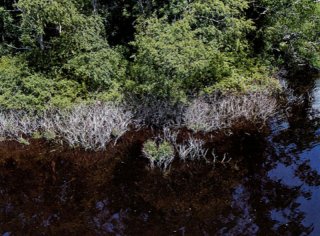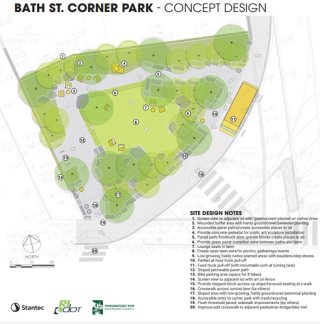Infrastructure Investment and Jobs Act (IIJA) Implementation
- SNEP Stormwater and Natural Infrastructure Grants (SNIG)
- Rhode Island Decentralized Wastewater Improvement Grant
- SNEP Model Responsible Management Entity (RME) Project
- Interagency Partnership with U.S Geological Survey
SNEP received $15 Million in additional funding over five years (beginning in 2022) to implement the mission of the Infrastructure Investment and Jobs Act (IIJA – also known as the Bipartisan Infrastructure Law (BIL)). To date, EPA-SNEP has created and implemented the following grants and programs with IIJA funding:
SNEP Stormwater and Natural Infrastructure Grants (SNIG)
ABOUT:
Southeast New England Program (SNEP) 2023 Stormwater and Natural Infrastructure Grant Request for Applications (RFA) was released on May 1, 2023. The grant competition was a single-phase process where eligible applicants were invited to apply for funding consideration by June 30, 2023.
The RFA set forth a competitive process to solicit up to six projects, to implement climate resilient infrastructure that promotes nature-based solutions (NBS), habitat restoration and protection to restore ecosystem services degraded by development, as well as planning related to these topics. In addition, through this RFA SNEP emphasized projects which:
- Take holistic and multi-disciplinary approaches.
- Take place in the SNEP region.
- Produce multiple benefits (environmental, social, economic, carbon-sequestration, ecosystem service improvements, etc.).
- Support and/or leverage larger efforts, projects, or plans.
- Seek to plan or design for future, large-scale projects.
- Implement projects consistent with SNEP's Strategic Plan.
Four projects were selected for funding, worth a total of $6,581,535 ($2,168,021 Federal Funding; $4,413,514 Matching Funds).
PROJECTS SELECTED FOR FUNDING:
"Protecting Buzzards Bay Saltmarsh from Sea Level Rise: Resilience through Action, Knowledge Transfer and Outreach"
Massachusetts Audubon Society
Federal Request: $465,496
Match: $132, 284
The Massachusetts Audubon Society, in collaboration with partners including Save the Bay, Dartmouth Natural Resource Trust, the National Oceanic and Atmospheric Administration (NOAA), Bristol County Mosquito Control, Ducks Unlimited, Atlantic Coast Joint Venture, and Wareham Land Trust, seeks to protect saltmarsh through implementation and education. This project builds on the group's collective work, supported by a previous SNEP Watershed Implementation grant, to address the legacies of agriculture and infrastructure to restore and promote inland marsh migration on saltmarsh and adjacent low-lying areas on four Buzzards Bay coastal sites. This work includes implementing marsh migration and restoration methods on 160 acres on Buzzards Bay – building on ~60 acres of restored saltmarsh in these areas during the initial phase – that can be adapted for other Mass Audubon sanctuaries and project partners' properties throughout Southern New England. Mass Audubon's long-term vision for this project is a region-wide adoption of these saltmarsh migration and restoration practices; and the completion of marsh restoration and inland migration on a total cumulative 200 acres of Buzzards Bay saltmarsh that serves as a significant demonstration site for municipalities and landowners across the Buzzards Bay Watershed region as well as throughout the SNEP region and other coastal areas in New England.
"Lily Pond Stormwater and Habitat Restoration and Nantucket Harbor Watershed Green Infrastructure Planning"
Nantucket Land Bank
Federal Request: $600,000
Match: $625,150

Photo credit: Nantucket Land Bank.
View a larger version of image.
The Nantucket Land Bank (NLB or Land Bank) and its partner the Town of Nantucket Sewer and Stormwater Department (TON SSD), will construct Phase 1 of their planned wetland and stormwater system restoration at Lily Pond Park, in the Nantucket Harbor Watershed. In addition, the TON SSD proposes to expand the master planning process that was completed for Lily Pond to other areas within the watershed to scale up restoration activities. This effort will include a feasibility study to evaluate conditions and explore various green stormwater infrastructure improvements and wetland/stream restoration opportunities. The partners will identify project co-benefits, build consensus, and develop a final Master Plan to guide improvements within the downtown area that will address water quality in the Harbor and create a more sustainable and resilient community.
The overall goal of the Lily Pond Park project is to improve the hydrologic, ecological, and recreational functions of the Park by meeting the following four objectives: 1) improve the quality and better manage the quantity of stormwater coming into, stored within, and flowing out of the Park; 2) address the surrounding neighborhood impact including flooding, invasive control, and improved public access; 3) diversify habitats in the park through wetland restoration and invasive species management; and 4) improve the visitor experience within the park by enhancing entrances, improving accessibility, expanding internal circulation, and providing educational signage and outreach. These goals are consistent with the SNEP Strategic Plan's three broad goals of working towards a resilient ecosystem of safe and healthy waters, thriving watersheds and natural lands, and sustainable communities.
"Restoring the Ecological Resilience of the Kickemuit River"
Bristol County Water Authority
Federal Request: $600,000
Match: $3,330,000

Photo credit: BCWA
View a larger version of image.
The Bristol County Water Authority received $600k in SNEP Funds to contribute to the Lower Kickemuit Reservoir Dam and the Upper Kickemuit Reservoir Dam removals during the 2023 and 2024 construction seasons. This project has received significant support across a range of regional partners. SNEP Funds will add to the $3.3Million in matching funds already secured by the Bristol County Water Authority. The dam removal project will restore the estuarine habitat and water quality of the Kickemuit River by using nature-based solutions to increase the climate resilience of the restored watershed. The dam removals will improve the water quality of an impaired water body, restore a tidal estuary, restore salt marsh habitat, increase the salt marsh migration area under future sea level scenarios, increase carbon sequestration, and produce multiple benefits for the community, including increased community resilience and enhanced public access to this water body.
The goals of the project are to improve the water quality, restore estuarine habitat conditions of the Kickemuit River, and increase the community resilience of the watershed extending from the lower dam to upstream of the upper impoundment into Swansea, Massachusetts. The short-term outcomes of the dam removals include increased ecological health of the Kickemuit River by restoring the hydrologic connectivity of this tributary with the estuary, creation of approximately 38 acres of salt and brackish marsh habitat, enhanced habitat for oysters and estuarine and anadromous fish species, and improved water quality. The restored salt marsh will create a habitat for a wide variety of wading birds and salt marsh nesting species, such as the threatened saltmarsh sparrow and other marsh nesting birds, including the seaside sparrow and willet. Reduction in stagnant water and increased tidal flushing will increase oxygen levels and reduce water temperature. The restored estuary will be opened to public to access for kayaking, fishing, and other water recreation. The long-term outcomes of the dam removal include an increased area for salt marsh migration into wetlands and low-lying uplands in Warren, RI and Swansea, MA. Combined, these benefits will provide sustainable and lasting ecological benefits and will restore natural ecosystem functions to the Kickemuit River.
"Residents Lead Nature-Based Flood Mitigation and Stormwater Management in the Woonasquatucket River Watershed"
Woonasquatucket River Watershed Council
Federal Request: $507,026
Match: $326,080

Photo credit: WRWC
View a larger version of image.
The Woonasquatucket River Watershed Council (WRWC) will work with the City of Providence Department of Planning and Development (Planning) and the Rhode Island Department of Transportation Environmental Division (RIDOT) to complete design, permitting and construction of nature-based stormwater capture and treatment, active transportation, and recreational infrastructure along the Woonasquatucket River Greenway (Greenway). WRWC's advanced frontline resident leader group – Campeones, and WRWC's river and Greenway stewardship team – River Rangers, will work side-by-side with design consultants and construction contractors to understand, install, establish, and assure long-term effective function of the landscape and stormwater capture and treatment components at the three project sites.
The project will result in construction of a one-mile greenway along one of the most industrialized, urbanized section of Woonasquatucket River floodplain, create a Bath Street pocket stormwater park, install nature-based stormwater capture and treatment infrastructure at DeSota Street, and provide resident and green job training and long-term maintenance and stewardship.
Rhode Island Decentralized Wastewater Improvement Grant
ABOUT:
The Southeast New England Program’s Rhode Island Decentralized Wastewater Improvement grant opportunity was released on November 11, 2022. The competition was a single-phase process where eligible applicants were invited to apply for funding consideration by March 10, 2023.
The grant opportunity set out a competitive process to select up to three projects that would provide enhanced treatment of decentralized wastewater in Rhode Island through management, treatment system upgrades, education, developing financial incentives, and/or modeling.
Two projects were selected for funding, worth a total of $1,402,418 ($915,000 Federal Funding; $487,418 Matching/Leveraged Funds)
PROJECTS SELECTED FOR FUNDING:
"Expanded Implementation Plan for Decentralized Wastewater Improvement for Chepachet Village"
Town of Glocester, Rhode Island
Federal Request: $465,000
Matching Funds: $469,198
Much of southeastern New England relies on septic systems for their wastewater treatment needs. In our region, nitrogen from septic systems is a leading cause of coastal water pollution resulting in algal blooms, fish kills, excessive weeds, low water clarity and loss of critical seafloor habitat. Centralized sewering can be expensive and infeasible in many areas of our region. A potential solution is upgrading existing septic systems to Innovative/Alternative (I/A) septic systems that are specifically designed to increase removal of nitrogen. SNEP is using Bipartisan Infrastructure Law funding to support projects that help mitigate the effects of septic-borne nitrogen such as in the Town of Glocester, Rhode Island.
Through their award, the Town of Glocester will install I/A septic systems in the Chepachet Village area, establish a third-party management entity to manage newly installed systems, and develop a financial incentives and education program to encourage residents to upgrade their septic systems. Through these actions the Town enhance its wastewater treatment to ultimately decrease the amount of nitrogen entering its waterways, improve well-based drinking water, and increase water quality in the nearby Chepachet River.
"Upgrading Decentralized Wastewater in Coastal Neighborhoods, North Kingstown, Rhode Island"
Town of North Kingstown, Rhode Island
Federal Request: $450,000
Matching Funds: $18,220
Much of southeastern New England relies on septic systems for their wastewater treatment needs. In our region, nitrogen from septic systems is a leading cause of coastal water pollution resulting in algal blooms, fish kills, excessive weeds, low water clarity and loss of critical seafloor habitat. Centralized sewering can be expensive and infeasible in many areas of our region. A potential solution is upgrading existing septic systems to Innovative/Alternative (I/A) septic systems that are specifically designed to increase removal of nitrogen. SNEP is using Bipartisan Infrastructure Law funding to support projects that help mitigate the effects of septic-borne nitrogen such as in the Town of North Kingstown, Rhode Island.
Through their award, the Town of North Kingstown will conduct resident outreach and engagement, determine the location of at-risk septic systems and find homeowners who are willing to upgrade to I/A systems, and finally upgrade up to 30 old systems to I/A systems. Through these actions the Town hopes to increase homeowner awareness and knowledge of septic systems, while simultaneously decreasing the amount of nitrogen entering nearby waterways, thus improving water quality over time.
SNEP Model Responsible Management Entity (RME) Project
ABOUT:
The Southeast New England Program's Model Responsible Management Entity (RME) Project grant opportunity was released on April 20, 2022. The competition was a single-phase process where eligible applicants were invited to apply for funding consideration by June 17, 2022.
The grant opportunity set out a competitive process to select up to two projects that would develop pilot septic Responsible Management Entities in the SNEP Region. More information on Responsible Management Entities can be found HERE (pdf) .
One applicant was selected for funding, worth a total of $1,719,679 ($1,150,000 Federal Funding; $569,679 Matching/Leveraged Funds)
PROJECTS SELECTED FOR FUNDING:
"Development and Implementation of a Model Responsible Management Entity in Southeast Massachusetts"
Barnstable County, Massachusetts (Massachusetts Alternative Septic System Test Center)
Federal Request: $1,150,000
Matching Funds: $569,679
Much of southeastern New England relies on septic systems for their wastewater treatment needs. In our region, nitrogen from septic systems is a leading cause of coastal water pollution resulting in algal blooms, fish kills, excessive weeds, low water clarity and loss of critical seafloor habitat. Centralized sewering can be expensive and infeasible in many areas of our region. A potential solution is upgrading existing septic systems to Innovative/Alternative (I/A) septic systems that are specifically designed to increase removal of nitrogen. SNEP is using Bipartisan Infrastructure Law funding to support projects that help mitigate the effects of septic-borne nitrogen such as in southern Massachusetts.
Barnstable County's Massachusetts Alternative Septic System Test Center will lead the project and seeks to establish a Responsible Management Entity (RME) in up to four communities to oversee and facilitate the proper design, installation, operation, maintenance, and performance of I/A systems to reduce nitrogen in Cape Cod embayments and Buzzards Bay.
The primary goals of this project are to enhance regional operations, maintenance, and management of septic systems; install I/A systems; gather information on enhanced I/A performance; develop financial mechanisms to support the RME and future I/A system installations; and ultimately decrease the amount of nitrogen coming from septic-borne wastewater in southeastern Massachusetts. Specific tasks to be undertaken include: work with up to four communities to develop an RME frameworks; develop financial resources to fund RMEs and I/A system installations; develop a technical advisory committee to guide the development of RMEs; install numerous I/A systems; partner with local organizations and municipalities; monitor existing I/As as well as those to be installed; and share the results of this effort with MassDEP and other communities that may want to follow a similar path. EPA will share the results of this effort with MassDEP and other communities that may want to follow a similar path.
Interagency Partnership with U.S Geological Survey
"Susceptibility of Aquifers, Streams, Ponds, and Coastal Waters to Water-Quality Impairment from Septic-System Wastewater Disposal in Rhode Island"
U.S. Geological Survey
Federal Funds: $325,000
Much of southeastern New England relies on septic systems for their wastewater treatment needs. In our region, nitrogen from septic systems is a leading cause of coastal water pollution resulting in algal blooms, fish kills, excessive weeds, low water clarity and loss of critical seafloor habitat. Centralized sewering can be expensive and infeasible in many areas of our region. A potential solution is upgrading existing septic systems to Innovative/Alternative (I/A) septic systems that are specifically designed to increase removal of nitrogen. SNEP is using Bipartisan Infrastructure Law funding to support projects that help mitigate the effects of septic-borne nitrogen such as through a collaborative study with the U.S Geological Survey (USGS).
Through this study, which began in late 2023, USGS will develop models to (1) determine septic-system density and numbers, and basin characteristics of statewide drainage areas, (2) compile and rank relative magnitude of nitrogen inputs from wastewater and other sources in said drainage areas, (3) conduct water quality sampling to determine the relationship between septic density and observed nutrient concentrations, and (4) estimate the relative susceptibility of waterbodies statewide to the impacts of septic related nitrogen as well as other sources.
The results will hopefully provide SNEP and its partners an idea of which areas might need to be prioritized for decentralized wastewater improvements in the future.
